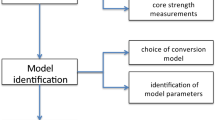Abstract
Test resuls of two different non-destructive test methods, the ultrasonic pulse velocity and Schmidt hammer, were used in conjuction with concrete mix proportions and density, to develop mathematical relationships using multiple linear regressions to obtain a first stage estimate of concrete compressive strength. These regressions covered both wet and air-dry concrete conditions. In each part of the work, a total number of 103 different mixes were tested at ages ranging between 7–90 days.
Second stage (more accurate) concrete strength estimates are then obtained by linear correlation between the first estimates of concrete strength from the first part of the work and actual strengths obtained from limited number of cores cut from the structure itself.
This procedure was tested on two separate building cases and was found to yield good predicted values with standard errors of estimate of 2.95. MPa for a concrete with range of strength of (15.7–33.8) MPa for the first case study, and a standard error of only 0.91 MPa for a concrete with range of strength of (12.5–23) MPa for the second case study.
Résumé
Deux méthodes d'essais non-destructifs différentes, la vitesse vibration des ultrasons et le scléromètre de Schmidt, ont été utilisés pour diverses formules et masses volumiques de béton.
Les résultats ont permis de développer un modèle mathématique de prévision de la résistance en compression. Ce modèle couvre les cas de conservation du béton en atmosphère humide et sèche. Dans chaque cas, il a été utilisé 103 mélanges, pour des essais réalisés à un âge allant de 7 à 90 jours.
Dans une deuxième étape, une estimation plus précise des résistances du béton a été réalisée par corrélation linéaire entre les valeurs de résistance obtenues dans la première partie, et les valeurs réelles déterminées sur quelques échantillons prélevés par carrotage sur l'ouvrage.
Cette procédure a été appliquée avec succès aux cas de deux ouvrages: écart-type de 2,95 MPa pour une résistance de 15,7 à 33,8 MPa (premier cas)—écart-type de 0,91 MPa pour un béton d'une résistance de 12,5 à 23 MPa (deuxième cas).
Similar content being viewed by others
References
Samarin, A. and Dhir, R., ‘Determination of in situ concrete strength: Rapidly and confidently by non-destructive testing’, In situ non-destructive testing of concrete, SP-82, (American Concrete Institute, Detroit, 1984), pp. 201–227.
Facaoaru, I., ‘Romanian achievements in non-destructive strength testing of concrete’, In situ non-destructive testing of concrete, SP-82, (American Concrete Institute, Detroit, 1984), pp. 33–56.
Facaoaru, I., ‘Non-destructive testing of concrete in Romania’, Proc. symposium on non-destructive testing of concrete and timber, I.C.E., (London, 1969), pp. 23–43.
Tanigawa, Y., Baba, K. and Mori, H., ‘Estimation of concrete strength by combined non-destructive testing methods’, In situ non-destructive testing of concrete, SP-82, (American Concrete Institute, Detroit, 1984), pp. 195–199.
Akman, M. S., and Guner, A., ‘The applicability of Sorneb method on damaged concrete’,Mater. Struct. 17 (99) (1984) pp. 195–199.
Samarin, A., and Meynink, P., ‘Use of combined ultrasonic and rebound hammer method for determining strength of concrete structural members’, Concrete International, (March 1981), pp. 25–29.
Samarin, A. and Dhir, R. K., ‘Determination of In Situ Concrete Strength: Rapidly and confidently by Non-destructive Testing’, In situ non-destructive testing of concrete, SP-82, (American Concrete Institute, Detroit, 1984), pp. 77–94.
Galan, A., ‘Determination of the strength characteristics of concrete based on ultrasonic wave propagation combined with rebound hammer data’,Mater. Struct. 17 (99) (1984) pp. 201–206.
Bellander, U., ‘NDT testing methods for estimating compressive strength in finished structures—evaluation of accuracy and testing system’, Symposium on Quality Control of Concrete Structures, Vol. 1, (Stockholm, June 1979), pp. 37–45.
Logothetis, L. and Tassios, T. P., ‘In situ assessment of concrete quality by means of three combined N.D. methods’, Symposium on Quality Control of Concrete Structures, Vol. 1, (Stockholm, June 1979), pp. 105–111.
BS 4408, Part 4, ‘Non-destructive methods of test for concrete surface hardness methods’, British Standards Institution, London.
Chapra, S. C. and Canale, R. P., ‘Numerical methods for engineers and scientists’, (McGraw Hill, 1985).
Sturrup, V. R., Vecchio, F. J. and Caratin, H., ‘Pulse velocity as a measure of concrete compressive strength’, In situ non-destructive testing of concrete, SP-82, (American Concrete Institute, Detroit, 1984), pp. 201–227.
Zivkovic, S. D. and Kovacevic, T. M., ‘A possibility for generalizing the strength velocity relationship for ultrasonic assessment of in situ concrete strength’, Proc. of the International Conference on structural faults and repair, Vol. 1, (London, July 1987), pp. 129–135.
Nasser, K. W. and Al Manaseer, A. A., ‘Comparison of non-destructive testers of hardened concrete’,ACI Materials Journal, Proceedings 84 (5) (Sept.–Oct. 1987) pp. 374–380.
Tomsett, H. N., ‘Ultrasonic pulse velocity measurement in the assessment of concrete quality’,Magazine of Concrete Research 32 (110) (March 1980), pp. 7–16.
Kennedy, J. B. and Neville, A. M., ‘Basic statistical methods for engineers and scientists’, Third edition, (Harper and Row Publishers, Inc., New York, 1986), pp. 428–430.
Author information
Authors and Affiliations
Rights and permissions
About this article
Cite this article
Kheder, G.F. A two stage procedure for assessment of in situ concrete strength using combined non-destructive testing. Mat. Struct. 32, 410–417 (1999). https://doi.org/10.1007/BF02482712
Received:
Accepted:
Issue Date:
DOI: https://doi.org/10.1007/BF02482712




